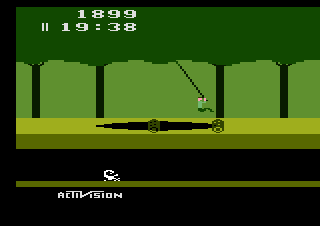Interestingly, the 2600 used almost the same CPU (the 6507) as the NES (6502) and Commodore 64 computer (6510). According to Wikipedia, the 6507 was a smaller version of the NES's 6502, while the 6510 was an expanded version of the 6502 . The 6502 supported 64 KB of address space (16-bit addressing), while the 6507 supported 8 KB (13-bit addressing); the 6502 also supported (external) hardware interrupts (the vertical blank interrupt, in the case of the NES), while the 6507 did not.
In contrast to the NES's 2 KB and SNES's 128 KB, the 2600 had an amazing 128 bytes of RAM (although more could be added on cartridges, for a manufacturing price). Early 2600 games came in 2 KB ROMs, although the system supported up to 32 KB with bank switching (4 KB at a time); in comparison, NES games ranged from (I think) 32 KB to 768 KB (also with bank switching: 32 KB at a time), although in theory it could support more.
But by far the most "interesting" thing about the system was the graphics system. Unlike the NES, SNES, and pretty much all consoles and computers made in the last three decades, the 2600 had no video RAM to speak of. Instead of storing on-screen image data in video memory which is then composed by the graphics chip and output to the display, on the 2600 the video was drawn actively, one line at a time; by "actively" I mean that the game had to compose each line as it was drawn by the television. Each line, 160 pixels wide, was composed of 24 two-color background blocks, 2 eight-bit single-color bitmap sprites, 2 single-color line "missiles" whose colors mirror those of the sprites, and a line "ball" that was much like the missiles, but was the color of the background.
However, while the hardware was very (very) limited, the ability (or necessity, in this case) to change the screen contents while drawing was underway provided some flexibility for the clever programmer (just like with the NES and SNES). Clever use of the missiles and ball, changing each scan line, allowed for more complex graphics than you'd imagine given the hardware capabilities. By changing the sprite configuration you could have more than two sprites, though having more than two sprites on the same scan line required alternating between them each frame, resulting in flicker. Alternating palettes allowed the system to display 4 different colors on each line (out of a total of 128), as well as multicolored sprites and backgrounds. Clever use of the missiles and ball allowed for additional sprites per line, or multi-color and non-block backgrounds. Developers even found that they could expand the background to a full 48 blocks (the background is 48 blocks wide, but the background is only 24 bits, describing the left half of the screen; the right side is formed by repeating or mirroring the left side) by modifying the background registers halfway through the line.
Finally, the 2600 had sound analogous but inferior to the NES's. It had two channels of sound, one generating a square wave of varying pitch, the other white noise. In comparison, the NES had five channels: 2 square wave (used to approximate most melodic instruments in music), one triangle wave (often for bass or low-frequency strings), a noise channel (used for drums and other percussion), and a waveform channel (I'm not familiar with any instances of this being used by games).
Pac Man, showing off more than two sprites and 48-block-wide backgrounds:

Pitfall, showing off multi-colored sprites and backgrounds, as well as (possibly) non-block backgrounds:




No comments:
Post a Comment